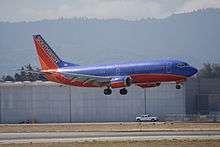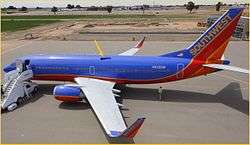Southwest Airlines Flight 812
 The Boeing 737–300 involved in the incident pictured in 2007. | |
| Incident summary | |
|---|---|
| Date | April 1, 2011 |
| Summary |
In-flight structural failure leading to rapid decompression |
| Site | near Yuma, Arizona |
| Passengers | 117 |
| Crew | 5 |
| Fatalities | 0 |
| Injuries (non-fatal) | 2 (minor) |
| Survivors | 123 (all) |
| Aircraft type | Boeing 737-3H4 |
| Operator | Southwest Airlines |
| Registration | N632SW |
| Flight origin | Phoenix Sky Harbor Int'l Airport (KPHX) |
| Destination | Sacramento Int'l Airport (KSMF) |
Southwest Airlines Flight 812 (SWA812, WN812) was a passenger flight which suffered rapid depressurization at 34,400 ft (10,485 m) near Yuma, Arizona, leading to an emergency landing at Yuma International Airport, on April 1, 2011. The incident caused minor injuries to two of the 123 aboard. The aircraft involved, a Boeing 737–300, was operating Southwest Airlines' domestic scheduled service from Phoenix Sky Harbor International Airport, Phoenix, Arizona, to Sacramento International Airport, Sacramento, California. The depressurization was caused by the structural failure of a lap joint in the fuselage skin due to metal fatigue. The aircraft made an emergency descent, and after landing, was found to have a hole approximately 60 inches (150 cm) long on top of the fuselage above the passenger cabin.[1][2][3][4] The NTSB investigation revealed evidence of pre-existing fatigue, and determined the probable cause of the incident to be related to an error in the manufacturing process for joining fuselage crown skin panels.[1] This incident led to the FAA increasing the inspection rate of certain airframes. The incident followed a similar one, Southwest Airlines Flight 2294, in 2009.
Aircraft
The aircraft involved was Boeing 737-3H4, registration number N632SW, manufacturer's serial number 27707,[5] line number 2799.[6] Manufacturing of the airframe was completed on May 22, 1996, and the aircraft was delivered to Southwest on June 13 of that year.[1][7] The aircraft fuselage was manufactured at Boeing's Wichita, Kansas facility, and was shipped in two pieces (forward and aft sections) by rail on April 1, 1996, from Wichita to Boeing's Renton, Washington facility for final assembly. The Renton facility then joined the forward and aft fuselage sections, completing a drilling and riveting process that had been intentionally left unfinished at the Wichita facility, for ease of production in Renton. The area of fuselage crown skin that would fail in this incident was at the site of the split manufacturing process, where work was partially performed in Wichita and finished in Renton.[1] At the time of the incident, the aircraft had completed 48,748 hours and 39,786 cycles.[6]
Incident

Flight 812 was a domestic scheduled passenger flight from Phoenix, Arizona to Sacramento, California. On April 1, 2011, it was carrying five crew and 117 passengers.[8] Takeoff and initial climb-out were normal. As the aircraft approached its cruising altitude, at approximately 15:58 local time (22:57 UTC),[9] while climbing through FL344 to reach FL360,[10] a loud bang was heard, recorded as an unidentified noise on the cockpit voice recorder. According to eyewitnesses, one of the ceiling panels dislodged.[2] About two seconds later, the captain announced that cabin pressurization had been lost, and called for oxygen masks on. At this point, sounds of increased wind noise were heard on the CVR. Cabin oxygen masks deployed. The captain declared an emergency to air traffic control, and received clearance to make an emergency descent. The pilots performed a rapid descent to 11,000 ft (3,353 m), where atmospheric pressure is sufficient to prevent hypoxia.[2] At this point the flight attendants began relaying reports to the pilots of an injury and a "two-foot hole" in the fuselage. The pilots requested a further descent to 9,000 feet (2,700 m) and vectors to the nearest airport that could accommodate the 737. The aircraft then landed without further incident at 16:23 at the joint Marine Corps Air Station Yuma/Yuma International Airport.[1][2][9]
One flight attendant and an off-duty airline employee received minor injuries, but were both treated at the airport.[10][11] The flight attendant had been attempting to make an interphone call to the pilots or a PA announcement to the passengers, instead of immediately donning his oxygen mask as he had been trained. As a result, he lost consciousness, fell, and struck the forward cabin partition, breaking his nose. An off-duty airline employee rushing to assist the flight attendant also lost consciousness, fell, and received a cut to the head. Both regained consciousness as the aircraft descended.[1] A spare aircraft with maintenance technicians, ground crew, and customer service agents was dispatched from Phoenix to take the passengers to Sacramento.[11] The replacement aircraft was expected to reach Sacramento with a 4-hour delay to the passengers on board Flight 812.[10]
This was the second structural failure, rapid decompression, and emergency landing for Southwest Airlines in two years. Southwest Airlines Flight 2294, also a 737–300, suffered a football-sized hole in its fuselage on July 13, 2009, in a similar incident. That aircraft also made a safe emergency landing.[12]
Aftermath

Inspection of the aircraft at Yuma revealed a section of fuselage skin had fractured and flapped open, causing the rapid decompression. Initial reports had the fuselage hole as being between 3 feet (91 cm) wide and 6 feet (180 cm) long.[10][13] The NTSB investigation determined the actual size of the fuselage hole to be approximately 60 inches (150 cm) long, and 8 inches (20 cm) wide.[1] Southwest grounded 80 of its Boeing 737-300s for inspection following the incident.[5] The grounded aircraft were those that had not had the skin on their fuselage replaced.[14] Five aircraft were discovered to have cracks.[15] The aircraft were to be repaired and returned to service.[14] As of April 3, 2011, Boeing was developing a Service Bulletin for the inspection of similar aircraft.[16]
On April 5, 2011, the FAA issued an emergency Airworthiness Directive (AD) requiring operators of 737 series 300, 400 and 500 aircraft to increase the frequency of inspections of lap joints on high flight cycle airframes. The AD requires that aircraft with over 30,000 cycles be inspected within 20 days of receipt of the AD, or upon reaching 30,000 cycles. For aircraft with over 35,000 cycles, the inspection is required within 5 days. The AD also requires periodic inspections of the same joints at every 500 cycles for aircraft with over 30,000 cycles.[17] The AD refers to a range of airframes, line numbers 2553–3132 inclusive, totaling 580 aircraft.[18] Of the total of 580 aircraft, only 175 aircraft currently meet the 30,000 cycle requirement, with 80 of those operating in the United States.[19] The FAA AD is effective to only the portion of those that are registered in the United States, since the FAA can only mandate such changes in the United States. Countries with reciprocity airworthiness agreements will also follow the AD, but other nations are not required to adhere to the ruling.[20] As a result of the incident, the FAA investigated Boeing's manufacturing techniques to discover whether or not they had any bearing on the cause of the failure. The incident aircraft was not considered to have a high number of cycles. Boeing co-operated with the FAA in the investigation.[21]
Air New Zealand inspected all fifteen of their 737-300s and Qantas inspected four of their 21 737-400s.[22] Several of the thirty-seven 737-400s operated by Malaysia Airlines were also to be inspected.[23]
Post-incident interviews showed the injured flight attendant had seriously overestimated his time of useful consciousness, and the NTSB renewed its criticism of the FAA's overly-optimistic time of useful consciousness tables and training requirements.[1]
Investigation
The Federal Aviation Administration sent an inspector to Yuma. The National Transportation Safety Board opened an investigation into the incident.[24] A Go Team was sent to Yuma on April 2.[6] Inspection of the 5 feet (1.5 m) long tear revealed evidence of pre-existing fatigue. The tear was along a lap joint. In March 2010, cracks had been found and repaired in the same place on the incident aircraft.[14][16] The cause was determined to have been a manufacturing error dating from when the aircraft was built.[6]
See also
References
- 1 2 3 4 5 6 7 8 "NTSB Report AAB-13-02" (PDF). www.ntsb.gov. National Transportation Safety Board. Retrieved January 5, 2016.
- 1 2 3 4 "Six-foot hole opens in 737 during flight". King5 News. Retrieved April 2, 2011.
- ↑ "'Plane going down. Love you'". MSNBC. Retrieved April 2, 2011.
- ↑ Pew, Glenn (April 2011). "Southwest In-Flight Fuselage Rupture (With Video)". AvWeb. Retrieved April 2, 2011.
- 1 2 Kaminski-Morrow, David. "Southwest grounds 80 737s after jet holed in flight". Flight International. Retrieved April 2, 2011.
- 1 2 3 4 "NTSB LAUNCHING TEAM TO INVESTIGATE AIRLINER FUSELAGE RUPTURE". National Transportation Safety Board. Retrieved April 2, 2011.
- ↑ "N632SW". Airframes. Retrieved April 2, 2011.
- ↑ "DCA11MA039" (PDF). National Transportation Safety Board. September 24, 2013. Retrieved September 27, 2013.
- 1 2 "N632SW Accident description". Aviation Safety Network. Retrieved April 3, 2011.
- 1 2 3 4 Hradecky, Simon. "Accident: Southwest B733 near Yuma on Apr 1st 2011, hole in fuselage, sudden decompression". Aviation Herald. Retrieved April 2, 2011.
- 1 2 "Southwest Airlines Responds to Loss of Pressurization Event on Flight From Phoenix to Sacramento". Southwest Airlines. Retrieved April 2, 2011.
- ↑ Goldsmith, Sam (July 14, 2009). "Southwest Airlines Flight 2294 lands in West Virginia with football-sized hole in fuselage". New York: NY Daily News. Retrieved April 2, 2011.
- ↑ "Holed Southwest Airlines flight makes emergency landing". BBC News. April 2, 2011. Retrieved April 2, 2011.
- 1 2 3 Christie, Bob. "NTSB: Cracks found in 3 grounded Southwest planes". Associated Press via KPUA Hawaii. Retrieved April 4, 2011.
- ↑ Ranson, Lori (April 7, 2011). "Southwest starts lap joint repairs on five aircraft". Flight International. Retrieved April 9, 2011.
- 1 2 "NTSB provides update on investigation of Southwest Flight 812" (Press release). NTSB. April 3, 2011.
- ↑ Maxon, Terry. "FAA issues emergency directive for Boeing 737 inspections". The Dallas Morning News. Retrieved April 5, 2011.
- ↑ Hradecky, Simon. "FAA Emergency Air Worthiness Directive regarding Boeing 737 skin cracks". Aviation Herald. Retrieved April 6, 2011.
- ↑ Ostrower, Jon. "Boeing issues service bulletin for premature 737 Classic lap-joint cracking". Flightglobal. Retrieved April 7, 2011.
- ↑ "FAA 737 inspection AD covers 175 jets". Leeham News and Comment. Retrieved April 7, 2011.
- ↑ Kirby, Mary (April 13, 2011). "MROAM: FAA studying Boeing manufacturing techniques after Southwest 737 rupture". Flight International. Retrieved April 14, 2011.
- ↑ Horton, Will (April 6, 2011). "ANZ and Qantas to inspect 737 Classics for fatigue cracks". Flight International. Retrieved April 9, 2011.
- ↑ Yeo, Ghil-Lay (April 8, 2011). "MAS carries out preliminary inspections on 737s". Flight International. Retrieved April 9, 2011.
- ↑ "Passengers Of Damaged Southwest Flight Arrive In Sacramento". CBS. April 1, 2011. Retrieved April 2, 2011.
External links
|
|
- "Southwest Airlines Responds to Loss of Pressurization Event on Flight From Phoenix to Sacramento." Southwest Airlines.
- Full list of operators affected by the AD